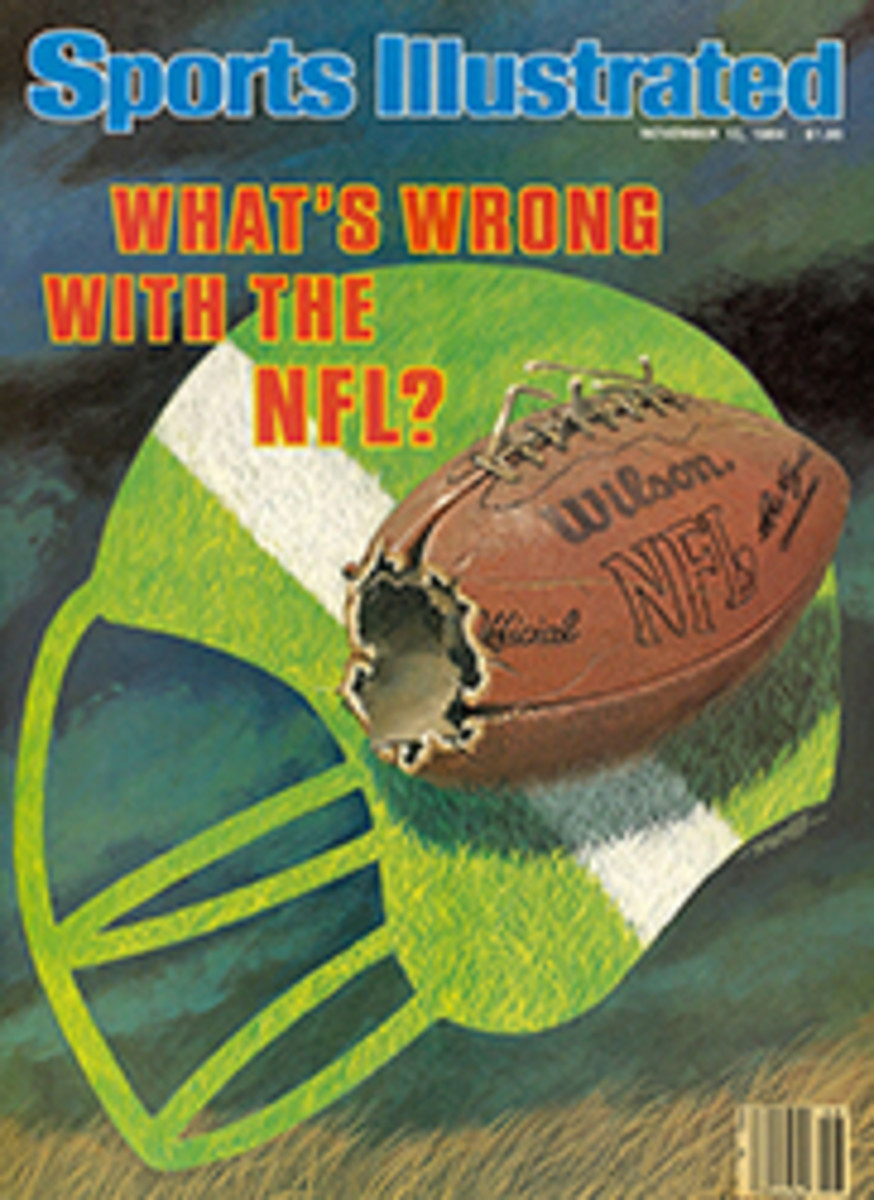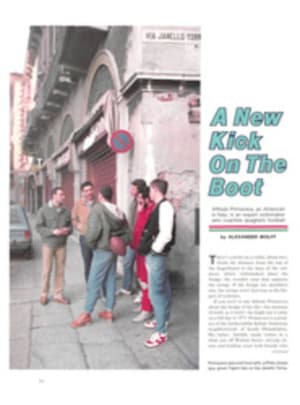
Flying Bikes And Wealthy Tykes
Waves of unmuffled engine noise reverberated off the walls of the Los Angeles Coliseum last Saturday night, as masked, helmeted figures sailed through the darkness on motorcycles, avoiding the occasional pileups on a rutted, muddy course that forced the riders to keep at least one wheel in the air about half the time. This was the Superbowl of Motocross, a hyped-up, flipped-out sporting extravaganza that's all mud, sweat and gears, an event full of 20-year-old millionaires with colorful nicknames. These boys just want to have fun.
Stadium motocross is different from regular motocross, which is conducted somewhere out there in the hills, and everything else, for that matter. In what other sport could you find motorcycles flying beneath the peristyle of the Coliseum and completing a Carl Lewis-style long jump to the stadium floor while 62,699 sudsed-up whackozoids scream for more noise, dirt and pills? At what other event would the sport's controversial impresario be able to count the house and call the shots while lying in a hospital bed recuperating from an injury suffered while he was racing? Stadium motocross has fireworks, beauty queens, truck giveaways and a list of corporate sponsors so long that at times it reads like the Dow Jones ticker tape.
True, plain old motocross is pretty wild, with the riders—frequently described as "the best-conditioned pro athletes in the world," at least by motorcycle magazines speaking through the mouths of physiologists—flying over rough terrain. But move the sport into a stadium and give competitors a chance to get rich, and you've got something else. Supercross is what Mike Goodwin calls it.
Goodwin, 39, is the sport's inventor, a fact he repeats about 100 times a day. He's a tireless promoter of Supercross and himself, not necessarily in that order. Last week, while preparations were being made for the Coliseum spectacular, Goodwin was in traction, first in his Laguna Beach home and then in the nearby South Coast Medical Center, under treatment for a couple of crushed vertebrae. The injury was sustained while Goodwin was indulging in another of his myriad passions, off-road car racing. Goodwin is a former music promoter—he did the first Burt Bacharach concert, which in his parlance means he invented Bacharach. According to press releases, he's also a gourmet whose favorite food is p√¢té de foie gras; a motocross grand prix national champion in the 30-and-over division (well, really it's a state championship, but all the best riders are from California); a world champion spear fisherman and underwater photographer (Goodwin likes to pass out copies of his award-winning picture of a sunken ship); a hunter who has killed a bear (brown) and a boar (wild) with a pistol; a real estate developer; a hotel owner; and a boat broker. And we're only touching the surface. The man is so busy that he always has two cassette tape recorders with him, one for his super-important brainstorms and another for merely important thoughts—plus a third that his wife, Diane, produces if one of the other two fails. Says Goodwin: "My goal is to be the best, and to live two lifetimes at once."
Tape recorders, in fact, are a big feature of the million-dollar-plus house the Goodwins have drilled into the side of a cliff that looms over the Pacific Ocean. The place is wired with six computerized tape recorders so that Goodwin can plug his enlightened, 3 a.m. ideas right into the "mainframe" downstairs and his secretary can have the paper work all ready for him in the morning. He picks it up right after he takes 11 minutes for brushing his teeth, shaving and combing his hair—Goodwin times everything—and as he begins another day of epic deal-making over a phone that has pasted upon it the admonition, SPEAK LOW AND SLOW.
A dozen years ago Goodwin was more or less broke. Then he invented Super-cross. The idea came to him after he had quit the music business and headed off aimlessly with Diane in a van, ending up in Central America. Goodwin was in Belize when he thought of moving motocross into a stadium, and before you could say "Abner Doubleday" his brainchild was a success. Goodwin is quick to note that Supercross has an average attendance of close to 57,000, which puts it in a league with the NFL. In fact, Super-cross drew the largest crowd in the history of Anaheim Stadium: 70,205 in 1982.
Aside from the crowds, the big surprise in Supercross is that many of the riders are making big money. The money comes from promotion-minded Japanese motorcycle manufacturers who sign the top riders to contracts worth as much as $300,000 a year. Then there are the bonus clauses. Honda, for instance, would pay Johnny (O'Show) O'Mara, 23, a $100,000 bonus if he could wrap up the national Supercross championship, which is based on points earned in a 15-race series held in stadiums from Buffalo to Seattle. L.A. was the final event of the year, and O'Mara had a 43-point lead going into it. Second place in the standings, however, was worth nothing to O'Mara; if he failed, his new nickname could be O'Pshaw.
"We're talking serious stuff," said Ken Clark, who's a team manager for Yamaha.
Most of the leading Supercross riders use special 250-cc factory bikes that cost the manufacturers hundreds of thousands of dollars to develop. The motorcycles are fast, and, it's hoped, durable. They also have 13 inches of suspension travel to cushion the rider against the jolts from a very rough course. At the Coliseum there were several spectacularly bumpy spots, among them the Peristyle Jump, where riders rocketed through the arch of the stadium and remained airborne down past 70 rows of bedazzled fans; the Catapult, a high ramp that sent the cycles about 30 feet in the air; and the Triple Jump, where riders not only had to fly, but also had to land precisely on the downside of a ramp 50 feet away.
"It just chews you up," says rider Broc (Golden Boy) Glover, a 24-year-old with a shock of snow-white hair and a matinee idol's profile. "When you get damage, half the time you don't even know it. After the race you think, 'God, that hurts.' This sport is brutal.
"People don't realize how athletic this stuff is. The amount of physical training we do is incredible. I run every day. I bicycle. I have a gym in my house. I'm even thinking of entering triathlons."
The big money and the star treatment have had the expected effect: "There are 16-year-old kids coming up with no brains just riding wide open," says O'Mara. "They're after our jobs."
Some of the riders, ungrateful wretches that they are, are also after Goodwin's job. They're miffed because Goodwin and other Supercross promoters pay small purses—usually only $1,500 to the winner—while the equipment manufacturers take care of the top dozen riders. Left out in the cold are the so-called privateers, nonfactory riders like 26-year-old Warren Reid. "I couldn't make a living even if I won every race," says Reid, who off the track is a wood finisher. O'Mara says, "All the privateers have is a lot of hard work, some bumps and bruises and no glory. The promoters are just using us."
"A lot of guys say bad things about me," says Goodwin, who counters such criticism by claiming a high overhead—all those truckloads of dirt to build the various temporary tracks around the country cost money. And besides, Goodwin says, he makes his big dough in real estate. "Right," says Glover sarcastically. "I won a race advertised at $50,000 this year and my prize was $840. And they had a bicycle race during the middle of it and the winner of that got $1,000."
All this carping was a pain in the neck to Goodwin, and he already had one of those. He checked into the hospital last Wednesday and set up headquarters. Goodwin had a speakerphone hooked up and donned special prism glasses that allowed him to view the telephone key pad without raising his head. "I'm not losing much efficiency," he said.
Meanwhile, back at the Coliseum, riders were facing a track that was a little softer than usual. The Coliseum management didn't want the Supercross tearing up its football field, so most of the moto route wended its way around the stadium perimeter. "This course is ridiculous," said David Bailey, 23, the reigning national champion and the only person with even a remote chance of catching O'Mara in the point standings. "Goodwin didn't want to spend the money for a real track."
O'Mara needed only six points to pick up the national title Saturday night, and he ended the speculation right away, taking the checkered flag in the first of four heats and thereby earning eight points and Honda's $100,000 bonus money. In the pits, everyone kept walking up and shaking his hand.
Later, in the 20-lap final, Glover jumped into a brief lead on the first straightaway, but Ron (the Machine) Lechien, who's only 17, shoved past him in the first turn. The Golden Boy was not pleased. After the Peristyle Jump, Glover's and Lechien's machines tangled, and both went down. Todd (Goat) Breker and Jeff (the Flying Freckle) Ward raced past them, flinging mud into the air.
Ward is typical of the circuit's dedicated, disciplined factory rider. At 13 he endorsed his own line of racing equipment; at 16 he became one of the youngest pro riders in motocross history. He has been on tour 10 months a year since 1978. Ward owns a lakefront home in Mission Viejo and drives a 930 Porsche Turbo. At 23 he looks like the kid next door. "You tell people he rides motorcycles and they think of leather jackets," says his girl friend, Molly Daley. "Then they see this fresh-faced guy with freckles."
On the third lap, Ward took the lead from Breker near the bottom of the Peristyle Jump and, while the riders behind him busied themselves with one another, roared far out in front. O'Mara got second, but never mounted a real challenge. "All I care about is the overall championship," O'Mara said afterward. "I got what I came for." The other big winner of the evening was Glover, who won $30,000 in a grand finale 10-lap Masters race.
Meanwhile, up in the press box, aides were passing out a release fresh from South Coast Medical Center. Goodwin had called with some exciting news: the announcement of a worldwide 1985 Super-cross Series, the Rodil Cup. Oh, yes, the promoter would also soon be leaving on a three-week trip to Australia, to be followed by a spring sojourn in France, where he and Diane like to eat two gourmet meals a day in the best restaurants. In addition, Goodwin plans to continue his off-road racing and is expected to defend his national-state motocross championship, as well as win several more honors in the fields of....
TWO PHOTOS
HEINZ KLUETMEIER
Ward lived up to his nickname, the Flying Freckle, when he soared to a first-place finish in the big race.
PHOTO
HEINZ KLUETMEIER
An airborne O'Mara (5) got the national title and $100,000 when he won the first heat.
PHOTO
HEINZ KLUETMEIER
Diane and Baggins comforted Goodwin, who ran the meet from his hospital bed.
PHOTO
GEORGE OLSON
At the Coliseum, riders roar down the perilous Peristyle Jump, a 70-row-long drop.
PHOTO
GEORGE OLSON
Glover came up golden in the Masters race, a 10-lap event that netted him $30,000.
PHOTO
HEINZ KLUETMEIER
Lechien, only 17, takes his bike over one of the 800-yard course's smaller jumps.

